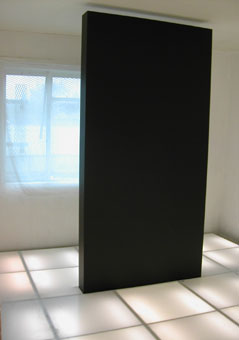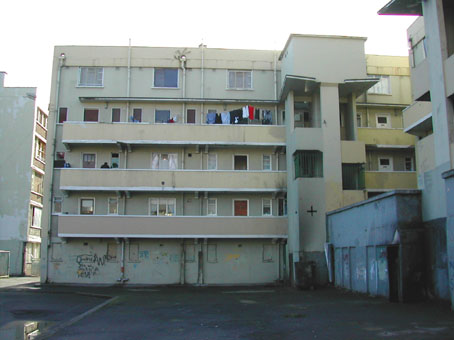 |
| Brendan Earley: Arrival installation shot, 2003; courtesy Pallas Studios |
Mankind’s vision of itself, seen from beyond the earth, exists in an empty place, surrounded by forgotten planets and fading stars. The Russian and American vision of lunar living is suspended in silence, lost and left behind. But traces of utopian ideals from the 1960s litter the world like the scratched surfaces of abandoned ships in the rubble of outer space.
Although dated and displaced, the fragments of modernist architecture, philosophy, art and science remain tangible in contemporary society. They are constructed from the desire to create a perfect future happiness for mankind.
Arrival by Brendan Earley at Pallas Heights evaluates the relevance of high-Modernist ideals in the twenty-first century. Using the model of a monolith from Stanley Kubrick’s celebrated film 2001: a space odyssey, he addresses the institutionalisation of paradise and demonstrates that the realisation of a single, static utopian ideal can only exist as a fictional construct.
The desire to create a utopia is not exclusive to the latter half of the twentieth century. In an essay for Art in America Tom McDonough discusses an exhibition at the New York Public Library, which explores the variety of systems employed throughout Western history to shape a perfect society. Pointing to early manuscripts by theologians, philosophers, social radicals and commercial developers from the fifteenth century, he concedes that the West’s preoccupation with utopian ideals stems from the wish to solve specific problems of the real world with imaginary constructs. Many of these dreams and ideologies are, in fact, the refracted images of specific moments in time. Inspired by nostalgia, the desire is to recapture these suspended moments and elevate “all humankind to the level of the gods. “ 1
Utopia as an isolated construct is best described by Thomas Moore in his seminal work Utopia; his island of perfection was located in the New World, providing Europeans with the perfect ’empty’ space on which to project their fantasies.
Kubrick’s images of the Earth, seen from space, unmarked by political boundaries, offered mankind a utopian vision of hope. They provided viewers with an escape from the horrors of the Vietnam War and the violence of the human-rights riots on the streets of America. The film explored mankind’s creation, fall and redemption.
The contrast between the ordered, clean, white spaces of Kubrick’s 2001 and the frenetic street protests of the 1960s exposes two different philosophical proposals for an ideal society: utopia as a closed structure and utopia as an open, fluid entity.
 |
| Block of flats where Arrival was housed; courtesy Pallas Studios |
In the bedroom of a block of semi-derelict apartments awaiting demolition, Earley’s monolith stands on an illuminated floor. The Pallas Heights Gallery space was once an isolated utopia. It now acts as a suitable site-specific venue for the issues raised and addressed in Earley’s work. The municipal housing development, designed in the latter half of the 1960s, has all the abandoned hope of “conjoining the transience of humanity with the eternal celestial realm." 2
Earley increases the tension between actual and imagined, dream and reality using light and sound. The soundtrack of the last scenes of the film, combined with the theatrical presence of the monolith, offers the viewer a unique and surreal experience of Dublin’s inner city. It exposes the disconnection, disillusionment and subsequent sense of failure experienced by those who designed these structures, and those who lived in them.
As society evolves, invents and reinvents itself in an unpredictable way, notions of fixed ideologies appear impractical. This is because utopias fail as immutable entities. The needs of a society are fluid and interchangeable. Arrival demonstrates why fixed utopian ideals inevitably become unsuitable environments for change. Left with the task of living and working in an inappropriate, static structure, a community becomes fractured and displaced. Arrival is a stimulating reflection on the experience of this failure.
Ciara Healy is an artist and writer based at Pallas Studios, Dublin.
Brendan Earley: Arrival , Pallas Heights Gallery, Dublin, October – December 2003
1 Tom McDonough, A thousand strange systems representing Utopia in the West, Art In America, June 2001
2 ibid.